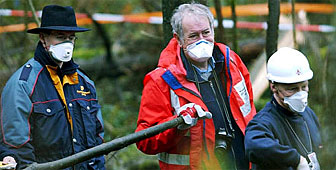Crossair to aid families of crash victims

Crossair will offer immediate financial aid to families of victims of Saturday's plane crash near Zurich airport. According to Crossair head André Dosé, each family will receive SFr30,000 ($18,028).
Survivors will also receive the sum, Dosé said. The airline will pay additional compensation over the coming weeks, according to applicable laws, and damages submitted for each passenger.
“We are continuing to do everything humanly possible to support the victims of this catastrophe,” Dosé said.
Crossair flight LX3597 was attempting a landing in poor weather on a runway used primarily by aircraft arriving after 10pm, when landings on the daytime runways are not permitted due to noise pollution regulations.
Twenty-four of the 33 people on the plane, which was arriving from Berlin, were killed in the crash. Nine people survived by scrambling from the burning wreckage.
Sonja Zöchling, spokeswoman for Zurich airport, told swissinfo the alternative runway – known as Runway 28 – has been in operation for the past 20 years, but its use by incoming aircraft had increased since the signing of a deal with neighbouring Germany last October to resolve a long-standing dispute over night time noise levels.
Zöchling admits Saturday’s crash is an unwelcome blow to confidence in the airport.
“With all the difficulties we’ve had in the past few weeks, we didn’t need this as well,” she said.
Zurich airport has come under mounting commercial pressure in recent weeks, following the collapse of Swissair, which uses the airport as its international hub.
Landings at night
The agreement with Germany means that flights arriving after 10pm are now authorised to land only on runway 28.
Pilots claim the descent to this runway is more complicated and requires far greater concentration than on the runways used during the day.
“The approach to runway 28 is not more dangerous, but needs much more attention in the cockpit. A step-by-step approach is needed,” said Olav Brunner, a former Swissair pilot.
“I compare the approaches to the main runway and to runway 28 as being like a motorway and a street in the mountains. On both, you can get to the target, but you need much more attention on a street in the mountains,” he added.
Zöchling argues that runway 28 complies with international aviation safety standards.
“It’s not a dangerous approach: it’s an official, international standard approach,” she said.
Instrument Landing System
Pilots need to focus more on the approach to runway 28, Brunner says, because unlike Zurich’s other runways, it is not equipped to respond to the on-board Instrument Landing System (ILS). Runways with an installed ILS device are able to guide aircraft automatically, which is particularly useful during periods of poor visibility or adverse weather conditions.
“I did this approach many times…and the workload in the cockpit is much higher than [if you are landing] on an ILS-equipped runway,” Brunner said.
Though the pilot of the ill-fated Crossair plane had to contend with adverse weather conditions on the approach to the airport, Brunner rejects the suggestion that snow or low cloud cover could have been a significant factor in the accident.
“You can certainly fly the plane in clouds without visibility and without visual references, though [on the final approach] you must be able to see the runway lights about 3.8km away from the airport,” he said.
Calls for ILS installation
Brunner says a number of pilots have called on authorities at Zurich airport to install ILS on runway 28 as a matter of urgency.
“The International Civil Aviation Organisation recommends such an ILS installation if the runway is used every day,” Brunner said.
“And since the agreement with the Germans, use of this runway is now compulsory every day, so it should be necessary to install this system,” he added.
Brunner argues the agreement with Germany was made “much too early”.
“They didn’t wait until this ILS was functioning, so the pilots have to do this complicated procedure.”
But the Swiss transport minister, Moritz Leuenberger, said on Monday that the agreement he signed with his German counterpart in October was not connected with the crash.
“This runway has been in use for 20 years…the political agreement has absolutely nothing to do with this tragic accident,” he said.
Daniel Güring, spokesman for the Civil Aviation Office, also rejects the suggestion that the political agreement has any connection with air traffic and safety issues.
“In our opinion it is not an issue because runway 28 was in use before the signing of the contract [with Germany] as a landing opportunity under heavy west wind conditions, so it’s nothing new to the pilots,” Güring said.
Officials at Zurich airport say they are considering the possibility of installing ILS on runway 28, but that the procedure could take as long as eighteen months to complete.
by Ramsey Zarifeh

In compliance with the JTI standards
More: SWI swissinfo.ch certified by the Journalism Trust Initiative








You can find an overview of ongoing debates with our journalists here . Please join us!
If you want to start a conversation about a topic raised in this article or want to report factual errors, email us at english@swissinfo.ch.